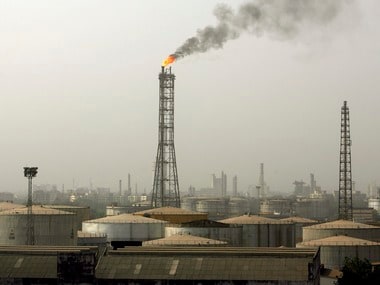Singapore: Oil prices held firm on Friday near three-year highs reached earlier this week as ongoing OPEC-led supply cuts as well as strong demand gradually draw down excess supplies.
Brent crude oil futures LCOc1 were at $73.79 per barrel at 0440 GMT, up 1 cent from their last close.
US West Texas Intermediate (WTI) crude futures CLc1 down 2 cents at $68.40 a barrel.
Both Brent and WTI hit their highest levels since November 2014 on Thursday, at $74.75 and $69.56 per barrel respectively. WTI is set for its second weekly gain, gaining 1.3 percent this week, while Brent is also poised to rise for a second week, adding 1.6 percent this week.

Representational image. Reuters
Oil prices have been pushed up by a gradually tightening market.
Led by top exporter Saudi Arabia, the Organization of the Petroleum Exporting Countries (OPEC), has been withholding production since 2017 to draw down a global supply overhang that had depressed crude prices between 2014 and 2016.
“Commercial inventories in the OECD are now essentially at their 5-year average, and drawdowns likely accelerate as refineries emerge from maintenance ahead of peak seasonal demand,” US investment bank Jefferies said on Friday.
“OECD commercial inventories could fall back to... a level not seen since the oil price collapse that began in 3Q14. On a days of forward demand basis, we believe cover could drop below 57 days later this year, a level last seen in 2011,” it added.
The tighter oil market is feeding into refined products.
“Signs of tightness are emerging in product markets as stocks saw the largest week-on-week draw since October, 2016 ... The US led the draws but was also aided by draws in Singapore,” said US bank Morgan Stanley.
This tightness is also a result of healthy oil demand.
“Global oil demand data so far in 2018 has come in line with our optimistic expectations, with 1Q18 likely to post the strongest year-on-year growth since 4Q10 at 2.55 million barrels per day,” US bank Goldman Sachs said in a note published late on Thursday.
Beyond OPEC’s supply management, crude prices have also been supported by an expectation that the United States will re-introduce sanctions on OPEC-member Iran.
“The first key geopolitical issue is the expiration of the current US waiver of key sanctions against Iran,” said Standard Chartered Bank in a note this week, referring to a deadline on 12 May when US President Donald Trump will decide whether or not to re-impose sanctions.
One factor that could start weighing on prices is rising US production C-OUT-T-EIA, which has jumped by a quarter since the middle of 2016 to 10.54 million barrels per day (bpd), making the United States the world’s second-biggest producer of crude oil behind only Russia, which pumps almost 11 million bpd.
Updated Date: Apr 20, 2018 11:59 AM



